Unit 3 Welcome to our school 单元知识点整理学案
文档属性
| 名称 | Unit 3 Welcome to our school 单元知识点整理学案 | 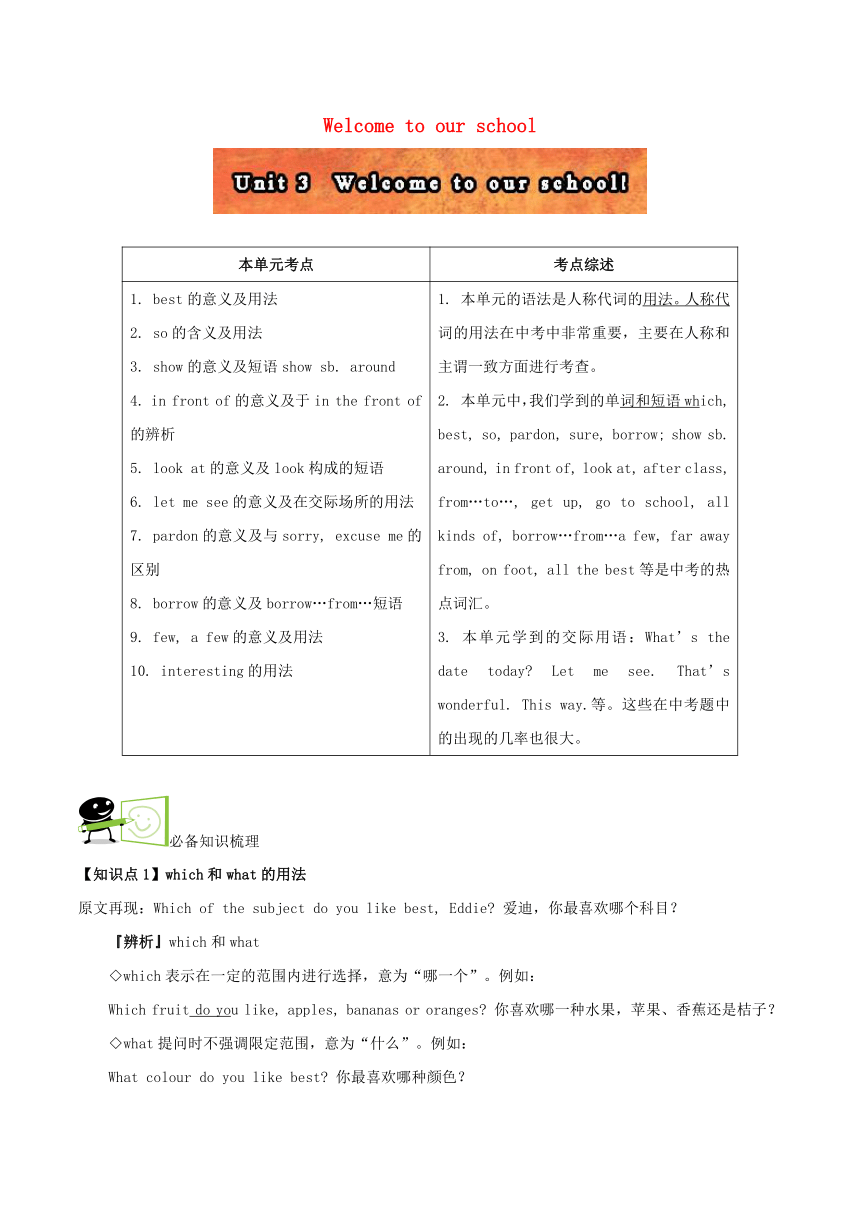 | |
| 格式 | zip | ||
| 文件大小 | 194.4KB | ||
| 资源类型 | 教案 | ||
| 版本资源 | 牛津译林版 | ||
| 科目 | 英语 | ||
| 更新时间 | 2016-08-26 07:51:50 | ||
图片预览

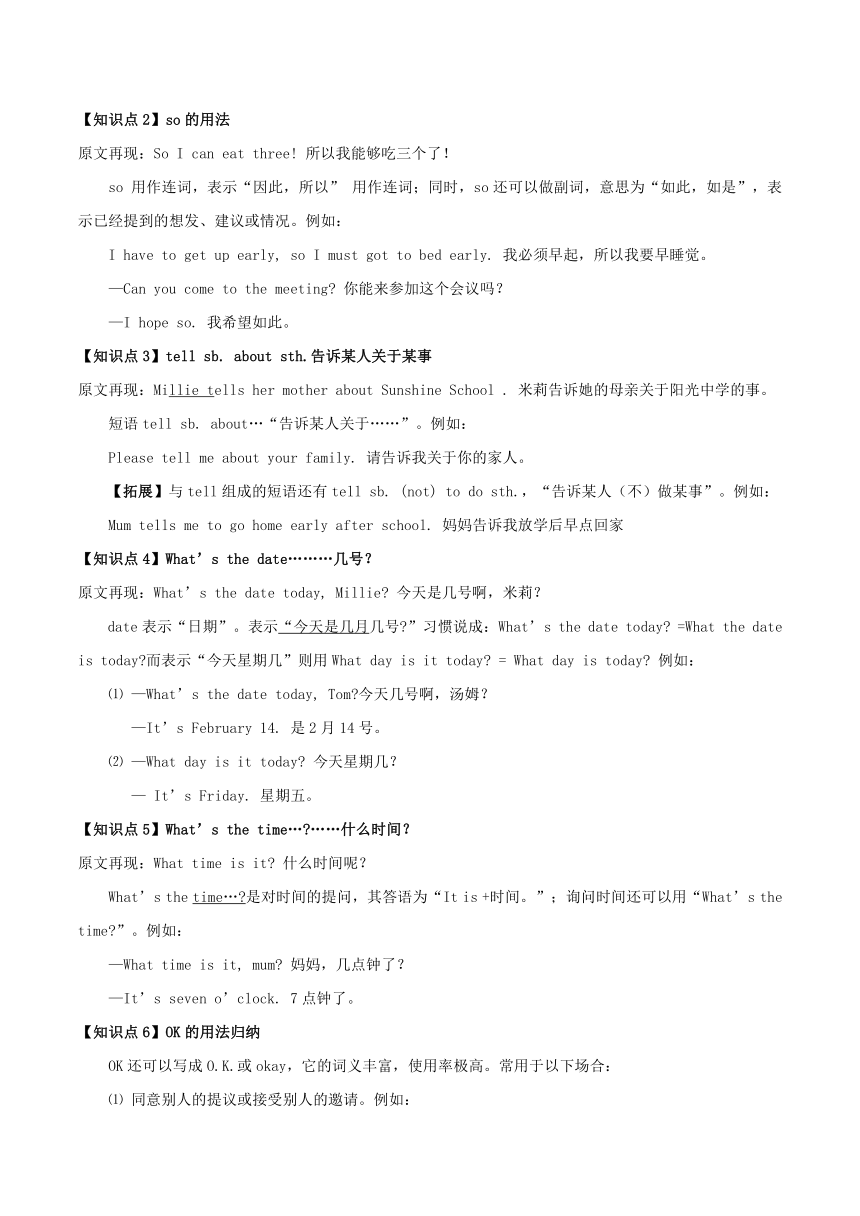
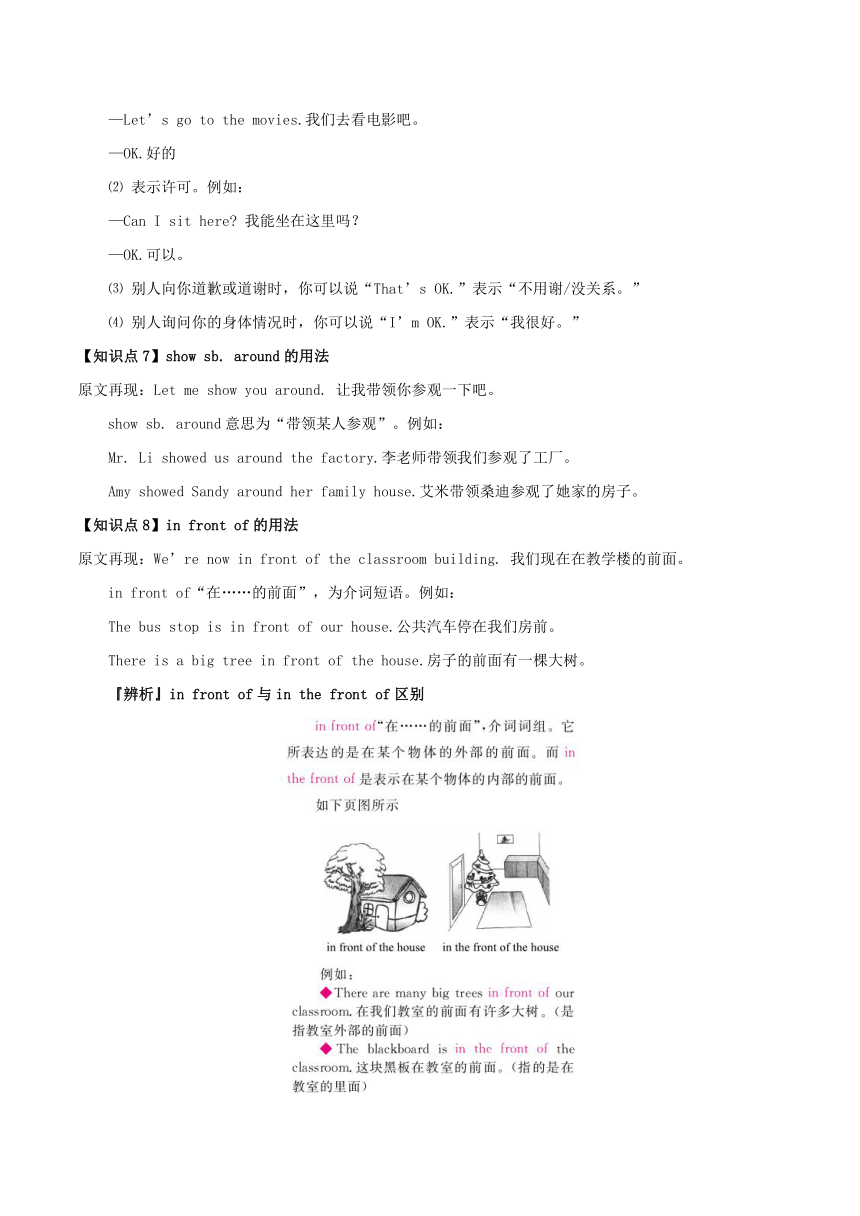
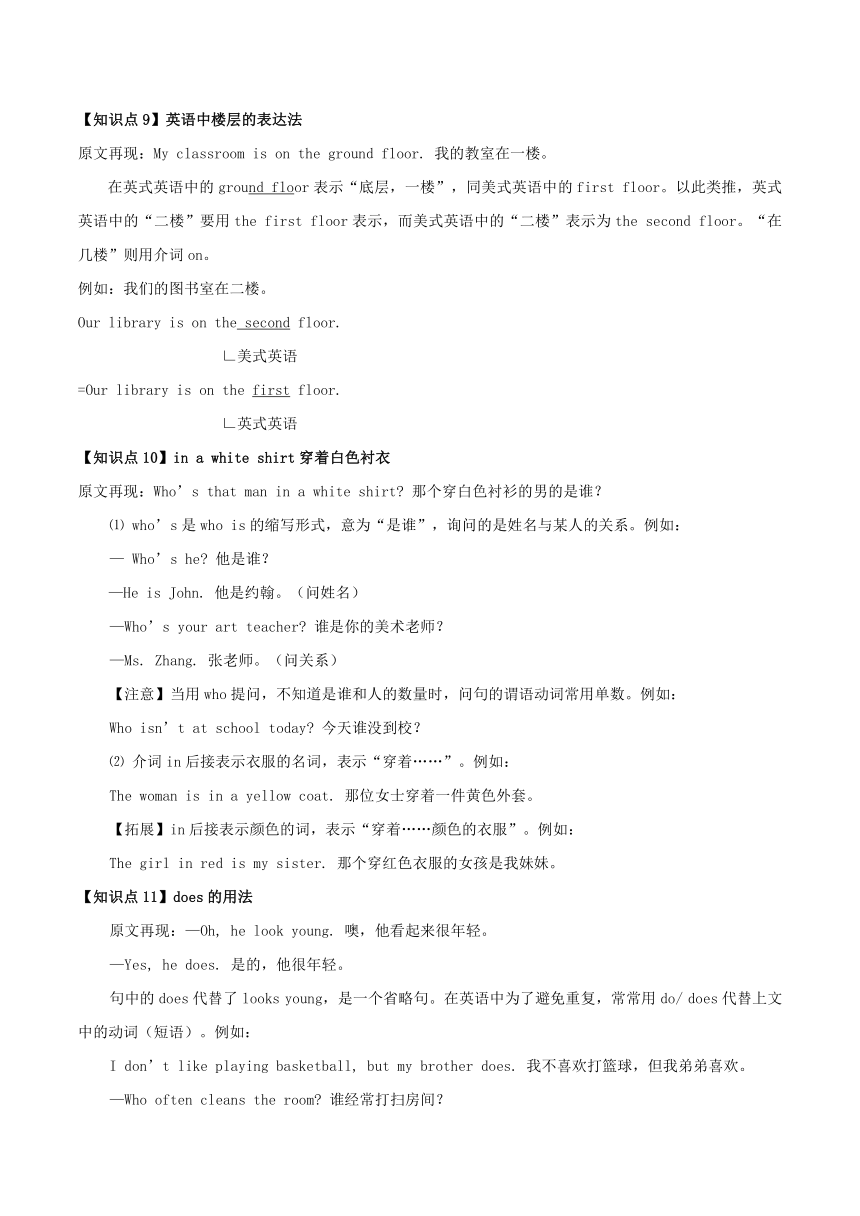
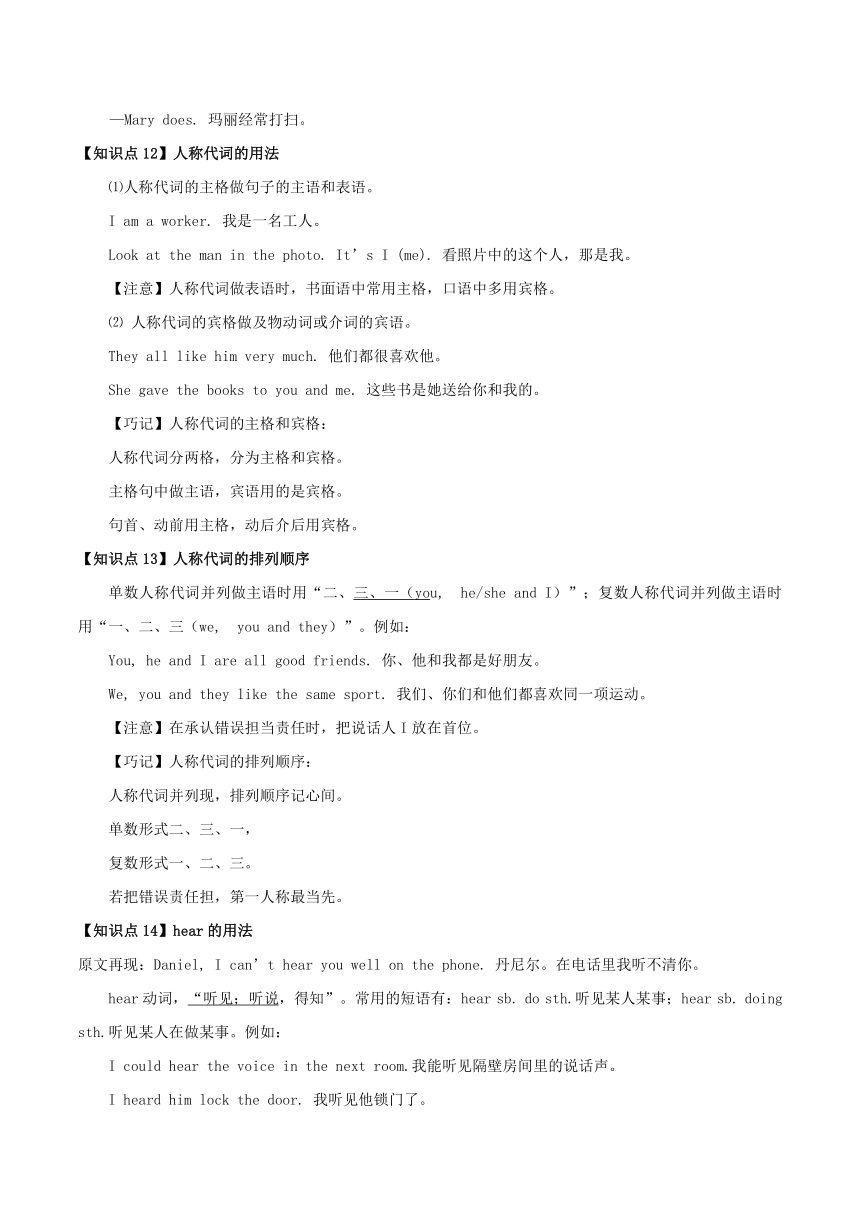
文档简介
Welcome
to
our
school
本单元考点
考点综述
1.
best的意义及用法2.
so的含义及用法3.
show的意义及短语show
sb.
around4.
in
front
of的意义及于in
the
front
of的辨析5.
look
at的意义及look构成的短语6.
let
me
see的意义及在交际场所的用法7.
pardon的意义及与sorry,
excuse
me的区别8.
borrow的意义及borrow…from…短语9.
few,
a
few的意义及用法10.
interesting的用法
1.
本单元的语法是人称代词的用法。人称代
( http: / / www.21cnjy.com )词的用法在中考中非常重要,主要在人称和主谓一致方面进行考查。2.
本单元中,我们学到的单词和短语wh
( http: / / www.21cnjy.com )ich,
best,
so,
pardon,
sure,
borrow;
show
sb.
around,
in
front
of,
look
at,
after
class,
from…to…,
get
up,
go
to
school,
all
kinds
of,
borrow…from…a
few,
far
away
from,
on
foot,
all
the
best等是中考的热点词汇。3.
本单元学到的交际用语:What’s
the
date
today
Let
me
see.
That’s
wonderful.
This
way.等。这些在中考题中的出现的几率也很大。
必备知识梳理
【知识点1】which和what的用法
原文再现:Which
of
the
subject
do
you
like
best,
Eddie
爱迪,你最喜欢哪个科目?
『辨析』which和what
◇which表示在一定的范围内进行选择,意为“哪一个”。例如:
Which
fruit
do
yo
( http: / / www.21cnjy.com )u
like,
apples,
bananas
or
oranges
你喜欢哪一种水果,苹果、香蕉还是桔子?
◇what提问时不强调限定范围,意为“什么”。例如:
What
colour
do
you
like
best
你最喜欢哪种颜色?
【知识点2】so的用法
原文再现:So
I
can
eat
three!
所以我能够吃三个了!
so
用作连词,表示“因此,所以”
用作连词;同时,so还可以做副词,意思为“如此,如是”,表示已经提到的想发、建议或情况。例如:
I
have
to
get
up
early,
so
I
must
got
to
bed
early.
我必须早起,所以我要早睡觉。
—Can
you
come
to
the
meeting
你能来参加这个会议吗?
—I
hope
so.
我希望如此。
【知识点3】tell
sb.
about
sth.告诉某人关于某事
原文再现:Millie
t
( http: / / www.21cnjy.com )ells
her
mother
about
Sunshine
School
.
米莉告诉她的母亲关于阳光中学的事。
短语tell
sb.
about…“告诉某人关于……”。例如:
Please
tell
me
about
your
family.
请告诉我关于你的家人。
【拓展】与tell组成的短语还有tell
sb.
(not)
to
do
sth.,“告诉某人(不)做某事”。例如:
Mum
tells
me
to
go
home
early
after
school.
妈妈告诉我放学后早点回家
【知识点4】What’s
the
date………几号?
原文再现:What’s
the
date
today,
Millie
今天是几号啊,米莉?
date表示“日期”。表示“今天是几月
( http: / / www.21cnjy.com )几号 ”习惯说成:What’s
the
date
today
=What
the
date
is
today 而表示“今天星期几”则用What
day
is
it
today
=
What
day
is
today
例如:
⑴
—What’s
the
date
today,
Tom 今天几号啊,汤姆?
—It’s
February
14.
是2月14号。
⑵
—What
day
is
it
today
今天星期几?
—
It’s
Friday.
星期五。
【知识点5】What’s
the
time… ……什么时间?
原文再现:What
time
is
it
什么时间呢?
What’s
the
time…
( http: / / www.21cnjy.com )是对时间的提问,其答语为“It
is
+时间。”;询问时间还可以用“What’s
the
time ”。例如:
—What
time
is
it,
mum
妈妈,几点钟了?
—It’s
seven
o’clock.
7点钟了。
【知识点6】OK的用法归纳
OK还可以写成O.K.或okay,它的词义丰富,使用率极高。常用于以下场合:
⑴
同意别人的提议或接受别人的邀请。例如:
—Let’s
go
to
the
movies.我们去看电影吧。
—OK.好的
⑵
表示许可。例如:
—Can
I
sit
here
我能坐在这里吗?
—OK.可以。
⑶
别人向你道歉或道谢时,你可以说“That’s
OK.”表示“不用谢/没关系。”
⑷
别人询问你的身体情况时,你可以说“I’m
OK.”表示“我很好。”
【知识点7】show
sb.
around的用法
原文再现:Let
me
show
you
around.
让我带领你参观一下吧。
show
sb.
around意思为“带领某人参观”。例如:
Mr.
Li
showed
us
around
the
factory.李老师带领我们参观了工厂。
Amy
showed
Sandy
around
her
family
house.艾米带领桑迪参观了她家的房子。
【知识点8】in
front
of的用法
原文再现:We’re
now
in
front
of
the
classroom
building.
我们现在在教学楼的前面。
in
front
of“在……的前面”,为介词短语。例如:
The
bus
stop
is
in
front
of
our
house.公共汽车停在我们房前。
There
is
a
big
tree
in
front
of
the
house.房子的前面有一棵大树。
『辨析』in
front
of与in
the
front
of区别
( http: / / www.21cnjy.com )
( http: / / www.21cnjy.com )
【知识点9】英语中楼层的表达法
原文再现:My
classroom
is
on
the
ground
floor.
我的教室在一楼。
在英式英语中的ground
flo
( http: / / www.21cnjy.com )or表示“底层,一楼”,同美式英语中的first
floor。以此类推,英式英语中的“二楼”要用the
first
floor表示,而美式英语中的“二楼”表示为the
second
floor。“在几楼”则用介词on。
例如:我们的图书室在二楼。
Our
library
is
on
the
second
floor.
∟美式英语
=Our
library
is
on
the
first
floor.
∟英式英语
【知识点10】in
a
white
shirt穿着白色衬衣
原文再现:Who’s
that
man
in
a
white
shirt
那个穿白色衬衫的男的是谁?
⑴
who’s是who
is的缩写形式,意为“是谁”,询问的是姓名与某人的关系。例如:
—
Who’s
he
他是谁?
—He
is
John.
他是约翰。(问姓名)
—Who’s
your
art
teacher
谁是你的美术老师?
—Ms.
Zhang.
张老师。(问关系)
【注意】当用who提问,不知道是谁和人的数量时,问句的谓语动词常用单数。例如:
Who
isn’t
at
school
today
今天谁没到校?
⑵
介词in后接表示衣服的名词,表示“穿着……”。例如:
The
woman
is
in
a
yellow
coat.
那位女士穿着一件黄色外套。
【拓展】in后接表示颜色的词,表示“穿着……颜色的衣服”。例如:
The
girl
in
red
is
my
sister.
那个穿红色衣服的女孩是我妹妹。
【知识点11】does的用法
原文再现:—Oh,
he
look
young.
噢,他看起来很年轻。
—Yes,
he
does.
是的,他很年轻。
句中的does代替了looks
young,是一个省略句。在英语中为了避免重复,常常用do/
does代替上文中的动词(短语)。例如:
I
don’t
like
playing
basketball,
but
my
brother
does.
我不喜欢打篮球,但我弟弟喜欢。
—Who
often
cleans
the
room
谁经常打扫房间?
—Mary
does.
玛丽经常打扫。
【知识点12】人称代词的用法
⑴人称代词的主格做句子的主语和表语。
I
am
a
worker.
我是一名工人。
Look
at
the
man
in
the
photo.
It’s
I
(me).
看照片中的这个人,那是我。
【注意】人称代词做表语时,书面语中常用主格,口语中多用宾格。
⑵
人称代词的宾格做及物动词或介词的宾语。
They
all
like
him
very
much.
他们都很喜欢他。
She
gave
the
books
to
you
and
me.
这些书是她送给你和我的。
【巧记】人称代词的主格和宾格:
人称代词分两格,分为主格和宾格。
主格句中做主语,宾语用的是宾格。
句首、动前用主格,动后介后用宾格。
【知识点13】人称代词的排列顺序
单数人称代词并列做主语时用“二、三、一(yo
( http: / / www.21cnjy.com )u,
he/she
and
I)”;复数人称代词并列做主语时用“一、二、三(we,
you
and
they)”。例如:
You,
he
and
I
are
all
good
friends.
你、他和我都是好朋友。
We,
you
and
they
like
the
same
sport.
我们、你们和他们都喜欢同一项运动。
【注意】在承认错误担当责任时,把说话人I放在首位。
【巧记】人称代词的排列顺序:
人称代词并列现,排列顺序记心间。
单数形式二、三、一,
复数形式一、二、三。
若把错误责任担,第一人称最当先。
【知识点14】hear的用法
原文再现:Daniel,
I
can’t
hear
you
well
on
the
phone.
丹尼尔。在电话里我听不清你。
hear动词,“听见;听说
( http: / / www.21cnjy.com ),得知”。常用的短语有:hear
sb.
do
sth.听见某人某事;hear
sb.
doing
sth.听见某人在做某事。例如:
I
could
hear
the
voice
in
the
next
room.我能听见隔壁房间里的说话声。
I
heard
him
lock
the
door.
我听见他锁门了。
【拓展】hear,
listen(to)的区别
⑴
listen(to)
“注意听”,表示有意识地去听,但是不一定能听见什么。强调“听”的动作。例如:
We
are
listening
to
the
teacher.我们正在听老师讲课。
Amy
is
listening
to
the
music.
艾米正在听音乐。
⑵
hear“听到;听见”,强调“听”的结果。例如:
She
heard
her
mother
coming
up
the
stairs.她听见她母亲上楼了。
I’m
sorry
to
hear
that.听到那个消息我很难过。
【知识点15】from…to..的用法
原文再现:It
is
a
long
way
from
my
home
to
the
school.
从我家到学校有很长的一段路。
from...to…“从……到……”,既可以与表示时间的词连用,也可以与表示地点的词连用。例如:
We
have
classes
from
8.00a.m.
to
11.40a.m.我们的课是从上午的8点到11.40.
We
often
walk
from
our
home
to
school.
我们经常从家里走到学校。
【知识点16】have
to的用法
原文再现:I
have
to
get
up
at…我不得不在……起床。
have
to意思为“必须,应该;不得不”,其第三人称单数为has
to。例如:
We
have
to
stay
at
home
because
of
the
rain.因为下雨,我们不得不呆在家里。
Tom
has
to
do
his
homework
every
day.汤姆不得不每天做作业。
【拓展】must与have
to的区别
◇
have
to“不得
( http: / / www.21cnjy.com )不,必须”,后跟动词原形。强调客观需要;其过去式是had
to,将来时态的形式是shall/will
have
to。口语中也常说have
got
to。它的特点是have有人称、时态的变化。例如:
I
have
to
go
now.我不得不走了。
∟表示客观需要
We
have
to
go
to
the
office
every
day.
我们每天都得上班。
◇
must则表示主观愿望,主观看法,只能用于一般现在时和一般将来时。例如:
We
must
finish
the
work
before
lunch.我们必须在午饭前完成这项工作。
I
must
go
now.我必须走了。
∟表示主观看法
【知识点17】how和get
to的用法
原文再现:How
does
she
get
to
school
他怎样到达学校?
◇
本句是how引导的特殊疑问句,其结
( http: / / www.21cnjy.com )构为“特殊疑问词+一般疑问句”。疑问词how意为“如何,以何种方式(手段)”,此时用于询问交通方式。例如:
How
does
your
father
go
to
work
every
day
你妈妈每天怎样去上班?
How
do
you
get
to
Beijing 你怎样去北京?
【拓展】交通方式的常见表达法:
⑴
“take
+
a/the+交通工具”是动词短语,在句中作谓语。
⑵“by+单数交通工具名词”是介词短语,作方式状语,常用于句尾。
⑶“walk
to+地点名词/
go
to+地点名词+on
foot”意为“步行去某地”。例如:
She
usually
takes
the
bus
to
school.
=She
usually
goes
to
school
by
bus.
她经常乘公共汽车去上学。
Let’s
walk
to
the
supermarket.
=Let’s
go
to
the
supermarket
on
foot.
让我们步行去超市。
【注意】on
foot,
by
bus/
bike/
car/
train等词组,名词前部加人恶化冠词或其他修饰词。
◇get
to意为“到达”,后面常接到达的地点。如果介词to后面接副词,如home,
here,
there等,则省略to。例如:
Millie
gets
to
school
at
7
o’clock
every
day.
米莉每天7点到校。
It
takes
me
about
half
an
hour
to
get
home
every
day.
每天花费我半个小时的时间到家。
【知识点18】how
long的用法
原文再现:How
long
does
it
take
那需要花多长时间?
how
long用于提问时间段,意为“多长时间,多久”,其答语为表示一段时间的名词性短语。例如:
—How
long
will
you
stay
in
Beijing
你要在北京待多久?
—About
a
week.大约一周。
【拓展】how
long,
how
soon,
how
often
◇
how
long意为“多久、多长时
( http: / / www.21cnjy.com )间”主要是对一段时间进行提问,答语通常是(for)
three
days/weeks/months等时间段,它可用于各种时态。
—How
long
did
the
meeting
last?这个会开了多长时间?
—About
half
an
hour.
大约半小时。
◇
how
soon意为“还要多久
( http: / / www.21cnjy.com )”,是对从某个基本时间到将来某动作结束或其动作发生这段时间提问,常用在一般将来时态的句子中,答语通常是“in十段时间”。
—How
soon
will
the
road
be
finished?这条路要多久才能完工?
—In
a
few
months.
几个月之内。
◇
how
often意为“隔多久”,用
( http: / / www.21cnjy.com )来提问在某一特定的时间进行某个动作的次数,答语通常是always,
usually,
often,
sometimes,
once/twice
a
week/month等。
—How
often
do
you
visit
your
uncle
你要隔多久去拜访你叔叔一次?
—Once
a
week.每周一次。
【知识点19】open的用法
原文再现:It’s
open
from
8
a.m.
to
5:30
p.m.
从早上的8点到下午的5.30。
在本句中open作形容词用,意思为“开放的,开着的”。例如:
Please
leave
the
door
open.请让门开着。
He
sleeps
in
a
room
with
the
window
open他在窗户开的那个屋子里睡觉。
【拓展】open还可以作为动词,意思是“打开,开启”。
Please
open
the
window.请把窗户打开。
Does
the
window
open
inwards
or
outwards
这个窗户是开着的还是朝外的?
【知识点20】there
be句型的用法
原文再现:Sure.
There
a
( http: / / www.21cnjy.com )re
all
kinds
of
books
in
our
library.当然。我们的图书馆里有各种各样的书。
这是there
be句型结构,表示“某处有某物(或某人)”,是表示存在意义的“有”,主语是紧接其后的名词,而不是后面的地点。例如:
There
is
a
dictionary
in
my
bag.
我书包里有一本英语词典。
●使用there
be结构时要注意三点:
⑴
there
be结构中的be必须和
( http: / / www.21cnjy.com )后面的主语保持一致。例如:There
are
two
CDs
in
the
box.
那个盒子里有两张光盘。
⑵
如果there
be结构中
( http: / / www.21cnjy.com )有几个名词(既有单数也有复数)作主语,be只和它最靠近的在数方面保持一致。例如:There
are
two
balls
and
a
cat
under
the
table.
桌子底下有两个球和一只猫。
⑶
不可数名词在there
be结构中
( http: / / www.21cnjy.com )作主语,be要用单数形式。例如:There
isn’t
any
milk
in
the
bottle.
那个瓶子里没有牛奶了。
【巧学妙计】there
be
句型使用口诀
there
be句型有特点,主语放在be后
( http: / / www.21cnjy.com )面。主语单数用is,复数主语要用are。变否定,很简单,be后要把not添。变问句也不难,把be提到there之前。肯定句中用some,否定/疑问要用any换。
【知识点21】borrow的用法
原文再现:Do
you
borrow
books
from
the
library 你能从图书馆里借书吗?
borrow意为“借用”。例如:
May
I
borrow
your
bike
我可以借用你的自行车吗?
【拓展】borrow和lend辨析
◇borrow是借进来,借过
( http: / / www.21cnjy.com )来,把本来不属于自己的东西拿来暂时使用。常用的短语为borrow
sth.
From
sb.表示“向某人借某物”。例如:You
may
borrow
the
book
from
the
library.
你可以从图书馆借这本书。
◇lend是借出去,把属于自己的东西借
( http: / / www.21cnjy.com )给别人暂时使用,常用于lend
sb.
sth.=lend
sth.
to
sb.结构,表示“把某物借给某人”。例如:Can
you
lend
me
your
bike
你能把自行车借给我吗。
【知识点22】interesting的用法
原文再现:It’s
interesting!
它很有趣!
interesting形容词,表示“引起兴趣的;有趣的”在句子中作表语和定语。例如:
The
film
is
very
interesting.这部电影很有趣。
It
is
an
interesting
book.
它是一本有趣的书。
【拓展】interesting与interested的区别
◇interesting是形容词,有主动意味,意为“令人有趣的”。作表语时,主语通常是
物。作定语时,既可修饰人,也可修饰物。
( http: / / www.21cnjy.com )例如:That’s
an
interesting
storybook
for
children.
那是一本有趣的儿童故事书。
◇interested是形容词。有被动意
( http: / / www.21cnjy.com )味,意为“感兴趣的、对……感兴趣”,主语通常是人,且多用于be/
get/
feel/
become
interested
in结构中。例如:
He
is
interested
in
playing
football.
他对踢足球感兴趣。
【知识点23】Thanks的用法
原文再现:Thanks
for
your
letter.
谢谢你的来信。
thank是及物动词,表示“谢谢,感激”,常
( http: / / www.21cnjy.com )用句型有:Thank
sb.
for
doing
sth.或Thank
sb.
for
sth.表示“感谢某人某事”。通常情况thank
you还可以说成thanks。for作介词,后面接名词或动词的-ing形式。例如:
Thank
them
for
their
help.
感谢他们的帮助。
Thank
you
for
tell
( http: / / www.21cnjy.com )ing
me
the
good
news.=Thanks
for
telling
me
the
good
news.谢谢你告诉我这个消息。
【知识点24】a
few的用法
原文再现:We
only
have
a
few
classroom.
我们只有几间教室。
a
few意为“一些,少量”,表示数量不多,用来修饰可数名词复数。例如:
She
has
a
few
friends.她有几个朋友。
【拓展】few、a
few、little、a
little的区别和联系
⑴
few
/
a
few用来修饰可数名词,few表示否定意义,没有,几乎没有;a
few表示有肯定意思,
有几个。
例如:
He
has
few
friends
here,
he
feels
lonely.
他这里没朋友,他感觉寂寞。
There
are
a
few
eggs
in
the
basket.篮子里有几个鸡蛋。
⑵
little
/
a
little
( http: / / www.21cnjy.com )用来修饰不可数名词,little表示否定意思,没有,几乎没有。a
little
表示肯定意思,有一点儿。
例如:
There
is
little
ink
in
my
bottle,
can
you
give
me
a
little
ink
我的瓶子里没有墨水了,你能给我点儿墨水吗?
【知识点25】far
away的用法
原文再现:I
live
far
away
from
the
school.
我住的离学校远。
far
away意为“遥远的”,还可以用作短语be
far
away
from,意为“远离”,只表示距离,away可省去。例如:
The
school
is
far
(away)
from
my
house.学校离我家很远。
Is
your
home
far
away
from
the
bus
stop
你的家离车站远吗?
【知识点26】It
takes
sb.
some
time
to
do
sth.花费某人多少时间做某事
原文再现:It
takes
me
abo
( http: / / www.21cnjy.com )ut
an
hour
to
get
to
school.
我每天步行去上学。大约花费我一个小时的时间达到学校。
句中take意为“花费(时间)”,
( http: / / www.21cnjy.com )常用it作形式主语,宾语大多是时间、金钱。常用句型为:It
takes(sb)
some
time
to
do
sth.。
例如:
It
takes
me
about
an
hour
to
get
there.我花了大约一个小时的时间达到那儿。
Just
a
minute,
it
won’t
take
me
long
to
change.
等一下,我很快就可以换好衣服。
直通中考
★经典考题解读
【考点1】考查形容词best的用法
(江苏常州)—
Tom,
what
do
you
think
of
the
school
—
Oh,
no
other
school
is
______
in
the
city.
It’s
______
one.
A.
better;
a
better
B.
the
best;
the
best
C.
better;
the
best
D.
the
best;
a
better
【答案】C
【考点2】考查a
few的用法
(湖北随州)—Is
your
friend
Michael
still
in
Australia
—I
don’t
know.
I
h
( http: / / www.21cnjy.com )ave
_____
information
about
him
because
we
haven’t
seen
each
other
for
_____
years.
A.
a
little;
a
few
B.
little;
a
few
C.
a
few;
a
little
D.
few;
a
little
( http: / / www.21cnjy.com )【答案】B
【考点3】考查动词borrow的用法
(辽宁大连)May I _____ your bike,
please I’ll give it back to you soon.
A.
touch
B.
bring
C.
borrow
D.
buy
【解析】考查动词词义辨析。touch“
( http: / / www.21cnjy.com )触摸”;bring“带来”;borrow“借用”;buy“买”。由下文句意“我将会尽快还给你”可推测,上文句意为“请问我可以借用你的自行车吗?”。
【答案】C
【考点4】考查It
take…to
do
sth.结构
(湖北荆州)It
usually
Mum
about
half
an
hour
to
cook
supper.
A.
pays
B.
takes
C.
spends
D.
costs
【解析】考查动词辨析。It
takes
sb.
some
time
to
do
sth.意思是“做某事花费某人一些时间”,因此选择B答案。
【答案】B
to
our
school
本单元考点
考点综述
1.
best的意义及用法2.
so的含义及用法3.
show的意义及短语show
sb.
around4.
in
front
of的意义及于in
the
front
of的辨析5.
look
at的意义及look构成的短语6.
let
me
see的意义及在交际场所的用法7.
pardon的意义及与sorry,
excuse
me的区别8.
borrow的意义及borrow…from…短语9.
few,
a
few的意义及用法10.
interesting的用法
1.
本单元的语法是人称代词的用法。人称代
( http: / / www.21cnjy.com )词的用法在中考中非常重要,主要在人称和主谓一致方面进行考查。2.
本单元中,我们学到的单词和短语wh
( http: / / www.21cnjy.com )ich,
best,
so,
pardon,
sure,
borrow;
show
sb.
around,
in
front
of,
look
at,
after
class,
from…to…,
get
up,
go
to
school,
all
kinds
of,
borrow…from…a
few,
far
away
from,
on
foot,
all
the
best等是中考的热点词汇。3.
本单元学到的交际用语:What’s
the
date
today
Let
me
see.
That’s
wonderful.
This
way.等。这些在中考题中的出现的几率也很大。
必备知识梳理
【知识点1】which和what的用法
原文再现:Which
of
the
subject
do
you
like
best,
Eddie
爱迪,你最喜欢哪个科目?
『辨析』which和what
◇which表示在一定的范围内进行选择,意为“哪一个”。例如:
Which
fruit
do
yo
( http: / / www.21cnjy.com )u
like,
apples,
bananas
or
oranges
你喜欢哪一种水果,苹果、香蕉还是桔子?
◇what提问时不强调限定范围,意为“什么”。例如:
What
colour
do
you
like
best
你最喜欢哪种颜色?
【知识点2】so的用法
原文再现:So
I
can
eat
three!
所以我能够吃三个了!
so
用作连词,表示“因此,所以”
用作连词;同时,so还可以做副词,意思为“如此,如是”,表示已经提到的想发、建议或情况。例如:
I
have
to
get
up
early,
so
I
must
got
to
bed
early.
我必须早起,所以我要早睡觉。
—Can
you
come
to
the
meeting
你能来参加这个会议吗?
—I
hope
so.
我希望如此。
【知识点3】tell
sb.
about
sth.告诉某人关于某事
原文再现:Millie
t
( http: / / www.21cnjy.com )ells
her
mother
about
Sunshine
School
.
米莉告诉她的母亲关于阳光中学的事。
短语tell
sb.
about…“告诉某人关于……”。例如:
Please
tell
me
about
your
family.
请告诉我关于你的家人。
【拓展】与tell组成的短语还有tell
sb.
(not)
to
do
sth.,“告诉某人(不)做某事”。例如:
Mum
tells
me
to
go
home
early
after
school.
妈妈告诉我放学后早点回家
【知识点4】What’s
the
date………几号?
原文再现:What’s
the
date
today,
Millie
今天是几号啊,米莉?
date表示“日期”。表示“今天是几月
( http: / / www.21cnjy.com )几号 ”习惯说成:What’s
the
date
today
=What
the
date
is
today 而表示“今天星期几”则用What
day
is
it
today
=
What
day
is
today
例如:
⑴
—What’s
the
date
today,
Tom 今天几号啊,汤姆?
—It’s
February
14.
是2月14号。
⑵
—What
day
is
it
today
今天星期几?
—
It’s
Friday.
星期五。
【知识点5】What’s
the
time… ……什么时间?
原文再现:What
time
is
it
什么时间呢?
What’s
the
time…
( http: / / www.21cnjy.com )是对时间的提问,其答语为“It
is
+时间。”;询问时间还可以用“What’s
the
time ”。例如:
—What
time
is
it,
mum
妈妈,几点钟了?
—It’s
seven
o’clock.
7点钟了。
【知识点6】OK的用法归纳
OK还可以写成O.K.或okay,它的词义丰富,使用率极高。常用于以下场合:
⑴
同意别人的提议或接受别人的邀请。例如:
—Let’s
go
to
the
movies.我们去看电影吧。
—OK.好的
⑵
表示许可。例如:
—Can
I
sit
here
我能坐在这里吗?
—OK.可以。
⑶
别人向你道歉或道谢时,你可以说“That’s
OK.”表示“不用谢/没关系。”
⑷
别人询问你的身体情况时,你可以说“I’m
OK.”表示“我很好。”
【知识点7】show
sb.
around的用法
原文再现:Let
me
show
you
around.
让我带领你参观一下吧。
show
sb.
around意思为“带领某人参观”。例如:
Mr.
Li
showed
us
around
the
factory.李老师带领我们参观了工厂。
Amy
showed
Sandy
around
her
family
house.艾米带领桑迪参观了她家的房子。
【知识点8】in
front
of的用法
原文再现:We’re
now
in
front
of
the
classroom
building.
我们现在在教学楼的前面。
in
front
of“在……的前面”,为介词短语。例如:
The
bus
stop
is
in
front
of
our
house.公共汽车停在我们房前。
There
is
a
big
tree
in
front
of
the
house.房子的前面有一棵大树。
『辨析』in
front
of与in
the
front
of区别
( http: / / www.21cnjy.com )
( http: / / www.21cnjy.com )
【知识点9】英语中楼层的表达法
原文再现:My
classroom
is
on
the
ground
floor.
我的教室在一楼。
在英式英语中的ground
flo
( http: / / www.21cnjy.com )or表示“底层,一楼”,同美式英语中的first
floor。以此类推,英式英语中的“二楼”要用the
first
floor表示,而美式英语中的“二楼”表示为the
second
floor。“在几楼”则用介词on。
例如:我们的图书室在二楼。
Our
library
is
on
the
second
floor.
∟美式英语
=Our
library
is
on
the
first
floor.
∟英式英语
【知识点10】in
a
white
shirt穿着白色衬衣
原文再现:Who’s
that
man
in
a
white
shirt
那个穿白色衬衫的男的是谁?
⑴
who’s是who
is的缩写形式,意为“是谁”,询问的是姓名与某人的关系。例如:
—
Who’s
he
他是谁?
—He
is
John.
他是约翰。(问姓名)
—Who’s
your
art
teacher
谁是你的美术老师?
—Ms.
Zhang.
张老师。(问关系)
【注意】当用who提问,不知道是谁和人的数量时,问句的谓语动词常用单数。例如:
Who
isn’t
at
school
today
今天谁没到校?
⑵
介词in后接表示衣服的名词,表示“穿着……”。例如:
The
woman
is
in
a
yellow
coat.
那位女士穿着一件黄色外套。
【拓展】in后接表示颜色的词,表示“穿着……颜色的衣服”。例如:
The
girl
in
red
is
my
sister.
那个穿红色衣服的女孩是我妹妹。
【知识点11】does的用法
原文再现:—Oh,
he
look
young.
噢,他看起来很年轻。
—Yes,
he
does.
是的,他很年轻。
句中的does代替了looks
young,是一个省略句。在英语中为了避免重复,常常用do/
does代替上文中的动词(短语)。例如:
I
don’t
like
playing
basketball,
but
my
brother
does.
我不喜欢打篮球,但我弟弟喜欢。
—Who
often
cleans
the
room
谁经常打扫房间?
—Mary
does.
玛丽经常打扫。
【知识点12】人称代词的用法
⑴人称代词的主格做句子的主语和表语。
I
am
a
worker.
我是一名工人。
Look
at
the
man
in
the
photo.
It’s
I
(me).
看照片中的这个人,那是我。
【注意】人称代词做表语时,书面语中常用主格,口语中多用宾格。
⑵
人称代词的宾格做及物动词或介词的宾语。
They
all
like
him
very
much.
他们都很喜欢他。
She
gave
the
books
to
you
and
me.
这些书是她送给你和我的。
【巧记】人称代词的主格和宾格:
人称代词分两格,分为主格和宾格。
主格句中做主语,宾语用的是宾格。
句首、动前用主格,动后介后用宾格。
【知识点13】人称代词的排列顺序
单数人称代词并列做主语时用“二、三、一(yo
( http: / / www.21cnjy.com )u,
he/she
and
I)”;复数人称代词并列做主语时用“一、二、三(we,
you
and
they)”。例如:
You,
he
and
I
are
all
good
friends.
你、他和我都是好朋友。
We,
you
and
they
like
the
same
sport.
我们、你们和他们都喜欢同一项运动。
【注意】在承认错误担当责任时,把说话人I放在首位。
【巧记】人称代词的排列顺序:
人称代词并列现,排列顺序记心间。
单数形式二、三、一,
复数形式一、二、三。
若把错误责任担,第一人称最当先。
【知识点14】hear的用法
原文再现:Daniel,
I
can’t
hear
you
well
on
the
phone.
丹尼尔。在电话里我听不清你。
hear动词,“听见;听说
( http: / / www.21cnjy.com ),得知”。常用的短语有:hear
sb.
do
sth.听见某人某事;hear
sb.
doing
sth.听见某人在做某事。例如:
I
could
hear
the
voice
in
the
next
room.我能听见隔壁房间里的说话声。
I
heard
him
lock
the
door.
我听见他锁门了。
【拓展】hear,
listen(to)的区别
⑴
listen(to)
“注意听”,表示有意识地去听,但是不一定能听见什么。强调“听”的动作。例如:
We
are
listening
to
the
teacher.我们正在听老师讲课。
Amy
is
listening
to
the
music.
艾米正在听音乐。
⑵
hear“听到;听见”,强调“听”的结果。例如:
She
heard
her
mother
coming
up
the
stairs.她听见她母亲上楼了。
I’m
sorry
to
hear
that.听到那个消息我很难过。
【知识点15】from…to..的用法
原文再现:It
is
a
long
way
from
my
home
to
the
school.
从我家到学校有很长的一段路。
from...to…“从……到……”,既可以与表示时间的词连用,也可以与表示地点的词连用。例如:
We
have
classes
from
8.00a.m.
to
11.40a.m.我们的课是从上午的8点到11.40.
We
often
walk
from
our
home
to
school.
我们经常从家里走到学校。
【知识点16】have
to的用法
原文再现:I
have
to
get
up
at…我不得不在……起床。
have
to意思为“必须,应该;不得不”,其第三人称单数为has
to。例如:
We
have
to
stay
at
home
because
of
the
rain.因为下雨,我们不得不呆在家里。
Tom
has
to
do
his
homework
every
day.汤姆不得不每天做作业。
【拓展】must与have
to的区别
◇
have
to“不得
( http: / / www.21cnjy.com )不,必须”,后跟动词原形。强调客观需要;其过去式是had
to,将来时态的形式是shall/will
have
to。口语中也常说have
got
to。它的特点是have有人称、时态的变化。例如:
I
have
to
go
now.我不得不走了。
∟表示客观需要
We
have
to
go
to
the
office
every
day.
我们每天都得上班。
◇
must则表示主观愿望,主观看法,只能用于一般现在时和一般将来时。例如:
We
must
finish
the
work
before
lunch.我们必须在午饭前完成这项工作。
I
must
go
now.我必须走了。
∟表示主观看法
【知识点17】how和get
to的用法
原文再现:How
does
she
get
to
school
他怎样到达学校?
◇
本句是how引导的特殊疑问句,其结
( http: / / www.21cnjy.com )构为“特殊疑问词+一般疑问句”。疑问词how意为“如何,以何种方式(手段)”,此时用于询问交通方式。例如:
How
does
your
father
go
to
work
every
day
你妈妈每天怎样去上班?
How
do
you
get
to
Beijing 你怎样去北京?
【拓展】交通方式的常见表达法:
⑴
“take
+
a/the+交通工具”是动词短语,在句中作谓语。
⑵“by+单数交通工具名词”是介词短语,作方式状语,常用于句尾。
⑶“walk
to+地点名词/
go
to+地点名词+on
foot”意为“步行去某地”。例如:
She
usually
takes
the
bus
to
school.
=She
usually
goes
to
school
by
bus.
她经常乘公共汽车去上学。
Let’s
walk
to
the
supermarket.
=Let’s
go
to
the
supermarket
on
foot.
让我们步行去超市。
【注意】on
foot,
by
bus/
bike/
car/
train等词组,名词前部加人恶化冠词或其他修饰词。
◇get
to意为“到达”,后面常接到达的地点。如果介词to后面接副词,如home,
here,
there等,则省略to。例如:
Millie
gets
to
school
at
7
o’clock
every
day.
米莉每天7点到校。
It
takes
me
about
half
an
hour
to
get
home
every
day.
每天花费我半个小时的时间到家。
【知识点18】how
long的用法
原文再现:How
long
does
it
take
那需要花多长时间?
how
long用于提问时间段,意为“多长时间,多久”,其答语为表示一段时间的名词性短语。例如:
—How
long
will
you
stay
in
Beijing
你要在北京待多久?
—About
a
week.大约一周。
【拓展】how
long,
how
soon,
how
often
◇
how
long意为“多久、多长时
( http: / / www.21cnjy.com )间”主要是对一段时间进行提问,答语通常是(for)
three
days/weeks/months等时间段,它可用于各种时态。
—How
long
did
the
meeting
last?这个会开了多长时间?
—About
half
an
hour.
大约半小时。
◇
how
soon意为“还要多久
( http: / / www.21cnjy.com )”,是对从某个基本时间到将来某动作结束或其动作发生这段时间提问,常用在一般将来时态的句子中,答语通常是“in十段时间”。
—How
soon
will
the
road
be
finished?这条路要多久才能完工?
—In
a
few
months.
几个月之内。
◇
how
often意为“隔多久”,用
( http: / / www.21cnjy.com )来提问在某一特定的时间进行某个动作的次数,答语通常是always,
usually,
often,
sometimes,
once/twice
a
week/month等。
—How
often
do
you
visit
your
uncle
你要隔多久去拜访你叔叔一次?
—Once
a
week.每周一次。
【知识点19】open的用法
原文再现:It’s
open
from
8
a.m.
to
5:30
p.m.
从早上的8点到下午的5.30。
在本句中open作形容词用,意思为“开放的,开着的”。例如:
Please
leave
the
door
open.请让门开着。
He
sleeps
in
a
room
with
the
window
open他在窗户开的那个屋子里睡觉。
【拓展】open还可以作为动词,意思是“打开,开启”。
Please
open
the
window.请把窗户打开。
Does
the
window
open
inwards
or
outwards
这个窗户是开着的还是朝外的?
【知识点20】there
be句型的用法
原文再现:Sure.
There
a
( http: / / www.21cnjy.com )re
all
kinds
of
books
in
our
library.当然。我们的图书馆里有各种各样的书。
这是there
be句型结构,表示“某处有某物(或某人)”,是表示存在意义的“有”,主语是紧接其后的名词,而不是后面的地点。例如:
There
is
a
dictionary
in
my
bag.
我书包里有一本英语词典。
●使用there
be结构时要注意三点:
⑴
there
be结构中的be必须和
( http: / / www.21cnjy.com )后面的主语保持一致。例如:There
are
two
CDs
in
the
box.
那个盒子里有两张光盘。
⑵
如果there
be结构中
( http: / / www.21cnjy.com )有几个名词(既有单数也有复数)作主语,be只和它最靠近的在数方面保持一致。例如:There
are
two
balls
and
a
cat
under
the
table.
桌子底下有两个球和一只猫。
⑶
不可数名词在there
be结构中
( http: / / www.21cnjy.com )作主语,be要用单数形式。例如:There
isn’t
any
milk
in
the
bottle.
那个瓶子里没有牛奶了。
【巧学妙计】there
be
句型使用口诀
there
be句型有特点,主语放在be后
( http: / / www.21cnjy.com )面。主语单数用is,复数主语要用are。变否定,很简单,be后要把not添。变问句也不难,把be提到there之前。肯定句中用some,否定/疑问要用any换。
【知识点21】borrow的用法
原文再现:Do
you
borrow
books
from
the
library 你能从图书馆里借书吗?
borrow意为“借用”。例如:
May
I
borrow
your
bike
我可以借用你的自行车吗?
【拓展】borrow和lend辨析
◇borrow是借进来,借过
( http: / / www.21cnjy.com )来,把本来不属于自己的东西拿来暂时使用。常用的短语为borrow
sth.
From
sb.表示“向某人借某物”。例如:You
may
borrow
the
book
from
the
library.
你可以从图书馆借这本书。
◇lend是借出去,把属于自己的东西借
( http: / / www.21cnjy.com )给别人暂时使用,常用于lend
sb.
sth.=lend
sth.
to
sb.结构,表示“把某物借给某人”。例如:Can
you
lend
me
your
bike
你能把自行车借给我吗。
【知识点22】interesting的用法
原文再现:It’s
interesting!
它很有趣!
interesting形容词,表示“引起兴趣的;有趣的”在句子中作表语和定语。例如:
The
film
is
very
interesting.这部电影很有趣。
It
is
an
interesting
book.
它是一本有趣的书。
【拓展】interesting与interested的区别
◇interesting是形容词,有主动意味,意为“令人有趣的”。作表语时,主语通常是
物。作定语时,既可修饰人,也可修饰物。
( http: / / www.21cnjy.com )例如:That’s
an
interesting
storybook
for
children.
那是一本有趣的儿童故事书。
◇interested是形容词。有被动意
( http: / / www.21cnjy.com )味,意为“感兴趣的、对……感兴趣”,主语通常是人,且多用于be/
get/
feel/
become
interested
in结构中。例如:
He
is
interested
in
playing
football.
他对踢足球感兴趣。
【知识点23】Thanks的用法
原文再现:Thanks
for
your
letter.
谢谢你的来信。
thank是及物动词,表示“谢谢,感激”,常
( http: / / www.21cnjy.com )用句型有:Thank
sb.
for
doing
sth.或Thank
sb.
for
sth.表示“感谢某人某事”。通常情况thank
you还可以说成thanks。for作介词,后面接名词或动词的-ing形式。例如:
Thank
them
for
their
help.
感谢他们的帮助。
Thank
you
for
tell
( http: / / www.21cnjy.com )ing
me
the
good
news.=Thanks
for
telling
me
the
good
news.谢谢你告诉我这个消息。
【知识点24】a
few的用法
原文再现:We
only
have
a
few
classroom.
我们只有几间教室。
a
few意为“一些,少量”,表示数量不多,用来修饰可数名词复数。例如:
She
has
a
few
friends.她有几个朋友。
【拓展】few、a
few、little、a
little的区别和联系
⑴
few
/
a
few用来修饰可数名词,few表示否定意义,没有,几乎没有;a
few表示有肯定意思,
有几个。
例如:
He
has
few
friends
here,
he
feels
lonely.
他这里没朋友,他感觉寂寞。
There
are
a
few
eggs
in
the
basket.篮子里有几个鸡蛋。
⑵
little
/
a
little
( http: / / www.21cnjy.com )用来修饰不可数名词,little表示否定意思,没有,几乎没有。a
little
表示肯定意思,有一点儿。
例如:
There
is
little
ink
in
my
bottle,
can
you
give
me
a
little
ink
我的瓶子里没有墨水了,你能给我点儿墨水吗?
【知识点25】far
away的用法
原文再现:I
live
far
away
from
the
school.
我住的离学校远。
far
away意为“遥远的”,还可以用作短语be
far
away
from,意为“远离”,只表示距离,away可省去。例如:
The
school
is
far
(away)
from
my
house.学校离我家很远。
Is
your
home
far
away
from
the
bus
stop
你的家离车站远吗?
【知识点26】It
takes
sb.
some
time
to
do
sth.花费某人多少时间做某事
原文再现:It
takes
me
abo
( http: / / www.21cnjy.com )ut
an
hour
to
get
to
school.
我每天步行去上学。大约花费我一个小时的时间达到学校。
句中take意为“花费(时间)”,
( http: / / www.21cnjy.com )常用it作形式主语,宾语大多是时间、金钱。常用句型为:It
takes(sb)
some
time
to
do
sth.。
例如:
It
takes
me
about
an
hour
to
get
there.我花了大约一个小时的时间达到那儿。
Just
a
minute,
it
won’t
take
me
long
to
change.
等一下,我很快就可以换好衣服。
直通中考
★经典考题解读
【考点1】考查形容词best的用法
(江苏常州)—
Tom,
what
do
you
think
of
the
school
—
Oh,
no
other
school
is
______
in
the
city.
It’s
______
one.
A.
better;
a
better
B.
the
best;
the
best
C.
better;
the
best
D.
the
best;
a
better
【答案】C
【考点2】考查a
few的用法
(湖北随州)—Is
your
friend
Michael
still
in
Australia
—I
don’t
know.
I
h
( http: / / www.21cnjy.com )ave
_____
information
about
him
because
we
haven’t
seen
each
other
for
_____
years.
A.
a
little;
a
few
B.
little;
a
few
C.
a
few;
a
little
D.
few;
a
little
( http: / / www.21cnjy.com )【答案】B
【考点3】考查动词borrow的用法
(辽宁大连)May I _____ your bike,
please I’ll give it back to you soon.
A.
touch
B.
bring
C.
borrow
D.
buy
【解析】考查动词词义辨析。touch“
( http: / / www.21cnjy.com )触摸”;bring“带来”;borrow“借用”;buy“买”。由下文句意“我将会尽快还给你”可推测,上文句意为“请问我可以借用你的自行车吗?”。
【答案】C
【考点4】考查It
take…to
do
sth.结构
(湖北荆州)It
usually
Mum
about
half
an
hour
to
cook
supper.
A.
pays
B.
takes
C.
spends
D.
costs
【解析】考查动词辨析。It
takes
sb.
some
time
to
do
sth.意思是“做某事花费某人一些时间”,因此选择B答案。
【答案】B
同课章节目录
- 预备课程
- Lesson 1 Nice to meet you !
- Lesson 2 A happy family
- Lesson 3 A nice school
- Lesson 4 You look cool !
- Lesson 5 Wonderful things
- Lesson 6 Have nice food
- Lesson 7 Enjoy our days
- Lesson 8 Let's have fun !
- Unit 1 This is me
- Unit 2 Let's play sports
- Unit 3 Welcome to our school
- Unit 4 My day
- Unit 5 Let’s celebrate
- Unit 6 Food and lifestyle
- Unit 7 Shopping
- Unit 8 Fashion
